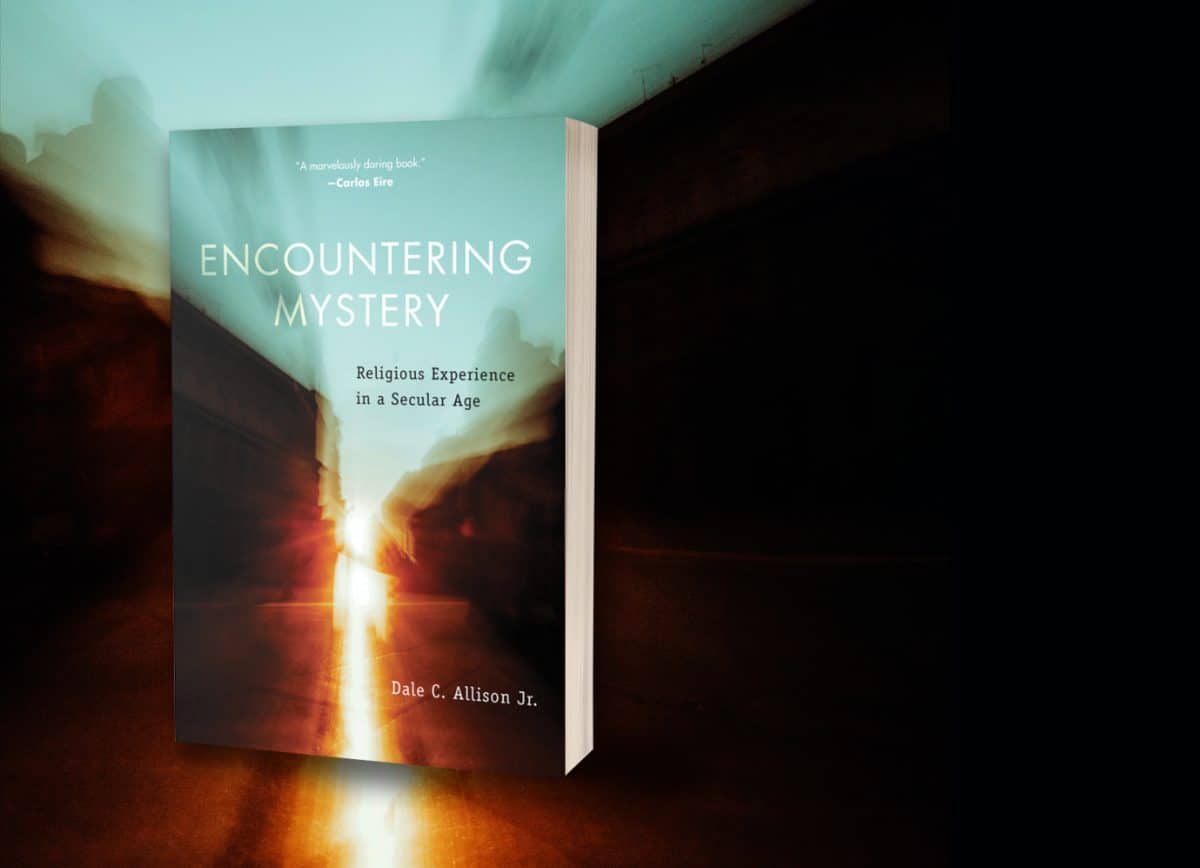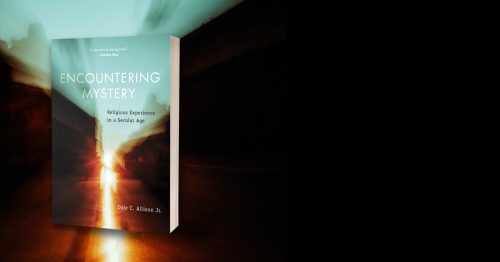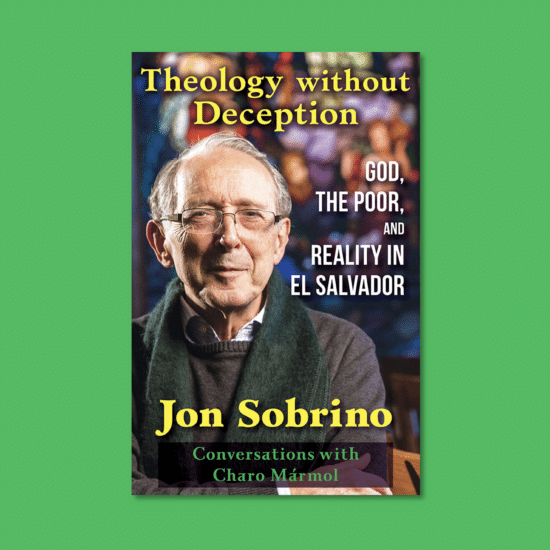

ENCOUNTERING MYSTERY: Religious Experience in a Secular Age. By Dale C. Allison Jr. Grand Rapids, MI: Wm. B. Eerdmans Publishing Company, 2022. X + 253 pages.
We live in a post-Enlightenment world. The Enlightenment, following David Hume, insisted that we should develop a healthy skepticism of out-of-the-ordinary claims to religious experiences. We should, Hume and others insisted, be wary of claims of experiences that cannot be verified, whether using scientific criteria or simply common human experience. Thus, over time, even religious people, especially religious scholars, have wanted to stick with the explainable. Or to use Rudolph Bultmann’s language, we should demythologize our faith in light of modern experience. Nevertheless, a lot of people report having had spiritual experiences that are not easily explained. This is especially true of near-death experiences. What should we make of these and other claims of extraordinary experiences?

Robert D. Cornwall
For the most part, religious scholars have stayed away from the kind of conversations that involve the unexplainable. For many of these scholars, delving into them could give the wrong impression to their colleagues. Nevertheless, there are those scholars who are willing to take the risk to reputation and mystery. One scholar who has chosen to cross the Rubicon and engage in such a thing is Dale C. Allison. Allison is a well-regarded New Testament professor who currently teaches New Testament at Princeton Seminary. While you might not expect Princeton professors to engage in such conversations that might be deemed undignified, that’s exactly what Allison has done.
As noted, Allison currently teaches at Princeton Theological Seminary, where he is the Richard J. Dearborn Professor of New Testament Studies. He has written numerous books and commentaries, including an important study of eschatology that I found very helpful—Night Comes: Death, Imagination, and the Last Things. The fact that Allison has already written about matters of death and last things, suggests that he is well prepared for engaging religious experience. What he seeks to do here is report on what others have shared regarding their experiences, while offering his take on these reports. While he approaches the subject with a high degree of openness, he does so with a healthy dose of skepticism. These are important qualities to bring to the table when dealing with what many deem to be extraordinary. While this book is written by a well-regarded scholar, it is not intended to be read as an academic treatise. Instead, he seeks to offer it as a pastoral work, seeking to help those who have had experiences sort them out.
Allison starts this conversation about religious experience by sharing several personal experiences that are out of the ordinary. In the opening chapter titled “Stars Descending,” he shares four convictions that guide the ensuing conversation. 1) He doesn’t believe that his own experiences are a mere curiosity. 2) The “theological idea of grace is not uninformed theory. Perhaps indeed grace is built into the structure of things.” 3) Cod can speak through the natural world. 4) “Appearances are deceiving. Things are not what they seem to be most of the time.” (pp. 6-7). These are, he writes, truths gained from personal experience.
The message from the beginning is that we should at least keep an open mind to reports of religious/spiritual experiences, some of which are a blessing and others that are not. While there have been academic studies of such phenomena, religious scholars often steer clear of these efforts. Interestingly, Allison reports that people are increasingly open to sharing their religious experiences. That’s because there appears to be less stigma about such experiences than was true in previous generations. While there is still scientific skepticism and disinterest among religious scholars, people are increasingly open to sharing their near-death experiences and angelic encounters. Ongoing hesitancy is based on the fact that not everyone is open to hearing these stories. That closes off avenues to share stories.
When we come to the book’s third chapter, Allison moves from setting out the parameters of this study to exploring more deeply reported experiences, some of which are blissful and others terrorizing. The latter stories involve experiences of oppressive spiritual forces. From this exploration of more generalized experiences that often come randomly and from places unexpected, he moves to prayer, noting the ways different people pray and what they experience in relation to those prayers. The point he wants to make here is that experiences of prayer vary widely. While prayer is a common experience among people of faith, there are less common experiences. Thus, having discussed how people pray, he moves on to “the Lore of Angels” in chapter 5. He reports that many reports of angel sightings involve a person appearing out of nowhere, dressed in white, experiences that have a biblical interpretive framework. While many of the reports can be explained as an “overinterpretation of mundane events,” not all such experiences can be explained in that way. Again, Allison is less interested in explaining these experiences than he is in reporting them. Having reported the experiences, he lets us, the reader, ponder the experiences of others which might help us explore our own experiences. In other words, he wants the reader to know that their experiences might seem out of the ordinary but might be shared with many others.
In Chapter 6 we move into conversations about death. He reports the various phenomena experienced by people as they approach death. These phenomena include seeing long-dead loved ones, who visit them to offer comfort as they transition from life into death. These “death bed visitations” or DBVs are rather common, and readers may have heard reports or experienced the appearance of persons after their deaths. From these DBVs, we turn to what Allison calls “Death from Within.” These are the Near-Death Experiences that are increasingly being reported. Again, Allison reports what others have shared, as well as studies that interpret such experiences. As with other reported experiences, he approaches them with an open mind. He notes that when it comes to understanding these experiences, “professional theologians and biblical scholars [are] of next to no hope. Most of them display not even a modicum of curiosity as they continue to write about death and eschatology with nary a word on NDEs. The unstated implication is that such experiences are irrelevant for theology and of no significance for deciding whether there might be something beyond death or what it might look like” (pp. 138-139). I will admit I have looked at reports of NDEs with a great deal of skepticism, assuming that they represent some form of brain response to approaching death. While this response is common, Allison helpfully opens us up to other possibilities without coming down on a particular interpretation. This chapter is probably worth the cost of the book. Those who have had these experiences do not experience them as being a dream. They are very real. So, perhaps we should pay attention.
The first seven chapters largely report the experiences of others. Although Allison shares some of his own experiences in these chapters, he focuses on reporting what others have experienced. Only in the final two chapters does he turn to the analysis of these reports. So, in Chapter 8 he offers a “Rational Analysis.” Here he takes note of the reports and how they come to be. While he admits he cannot vouch for the veracity of the testimonies, that doesn’t mean these testimonies don’t have value. He reminds us that while a single report, standing by itself, might not be of much value, the overwhelming number of reports of similar experiences requires at least some interest in the possibility that there is some truth. He writes that “my conviction is this. If enough people independently report the same sort of experience, that is reason to take note” (p. 153).
While the prior chapter focuses on rational analysis, it’s important to remember that Allison is not a social scientist or a philosopher. He’s a biblical scholar and theologian. While the rational analysis provides a foundation, Allison first and foremost has a theological interest in the question of religious experience. Thus, in chapter nine he tackles the theological issues involved in these discussions. After all, these are religious experiences. So, he brings to the conversation his expertise as a biblical scholar, using this expertise as a lens through which to interpret these reports. Since there are those within the Christian community who question the value of experience as an appropriate theological lens, he brings into the conversation what is often known as the Wesleyan Quadrilateral. Those who make use of this lens suggest that it’s important that in addition to Scripture, Tradition, and Reason, we consult Experience. Together the four sources of authority can give us a broader understanding of what it means to be Christian. As he engages in theological analysis, Allison warns against reductionism and disinterest, again calling for openness to reported religious experiences. He concludes the book by confessing that this isn’t a how-to book or a manual for mystics. Rather it provides an attempt to “enlarge understanding, as well as to counter ill-informed prejudices.” (p. 196).
There is a bit of boldness here. There are few incentives for an academic of his stature to engage in such a conversation. On the other hand, his long experience with academic study makes him a perfect person to report on and explore these experiences. While in other works he has functioned more as an academician, here he functions more as a journalist, reporting testimonies with an openness to the possibilities without embracing all of them. That is a helpful response.
Ultimately, this book is designed to assist in pastoral responses to religious experience. Thus, he closes Encountering Mystery by laying out the pastoral implications. While chapter 10 is brief in scope, it is true to its title: “The Pastoral Imperative.” We often hear that religious scholars are more interested in talking to other scholars, which is one reason they rarely take up topics such as this. In offering this book, Allison brings his expertise to the pastoral realm, helping clergy and the well-read layperson address questions of the validity of religious experience, especially the more out-of-the-ordinary and mysterious experiences like Near Death Experiences or Death Bed Visitations. Perhaps there is more to reality than can be demonstrated scientifically! At the same time, it’s appropriate to combine an open mind with a critical one!
This review originally appeared on BobCornwall.com.
Robert D. Cornwall is an ordained minister in the Christian Church (Disciples of Christ). Now retired from his ministry at Central Woodward Christian Church (Disciples of Christ) of Troy, Michigan, he serves as Minister-at-Large in Troy. He holds a Ph.D. in Historical Theology from Fuller Theological Seminary and is the author of numerous books including his latest books: Called to Bless: Finding Hope by Reclaiming Our Spiritual Roots (Cascade Books, 2021) and Unfettered Spirit: Spiritual Gifts for the New Great Awakening, 2nd Edition, (Energion Publications, 2021). His blog Ponderings on a Faith Journey can be found at www.bobcornwall.com.






